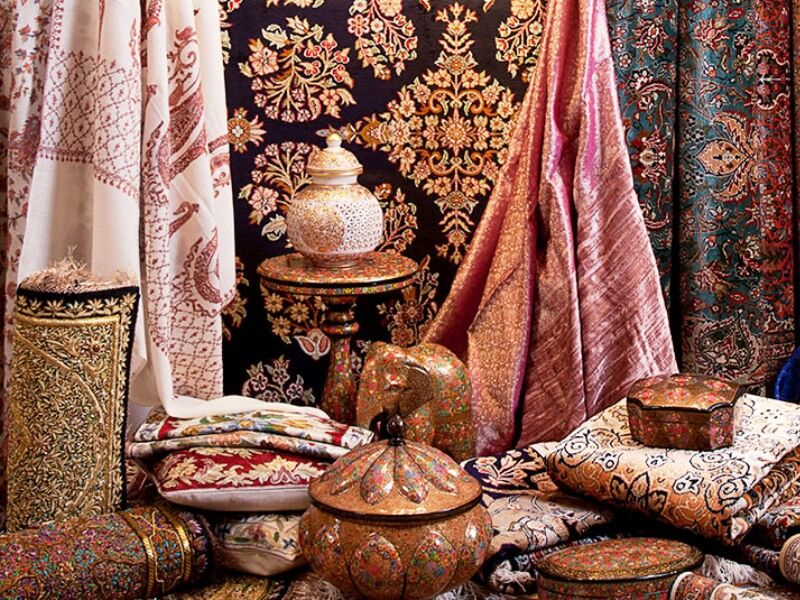Are you familiar with the handicrafts in Iran? Would you like to touch the past and experience the creativity and artistry of Iran, such as enamelwork and finger painting? Are you acquainted with the world of textile designs, handwoven carpets, the colors and glazes of ceramics, and copper vessels?
the vast country, of Iran, is not only known for its beautiful historical attractions but also for its diverse ethnicities and nationalities in every city. Each city, village, and corner has roots in the culture, art, and customs of the past. For this reason, the diversity of handicrafts in our country is very high and provides a window into the culture of the people of this land. It is impossible to capture all the beauty of handicrafts and the effort behind them, the love and artistry involved in their creation, in one article. However, Eligasht intends to introduce you to 12 of the most fascinating handicrafts in Iran.
Book Iran Air flights from London to Tehran and Tehran to London with Eligasht UK:
Handicrafts in Iran
Handicrafts are an important part of a country’s culture and hold special significance. By becoming familiar with the handicrafts of each city or country, one can learn more about the way of life of the people in the past. Nowadays, handicrafts have special importance and appeal to many people. Even when traveling, most people choose to buy the local handicrafts of a city as souvenirs. Therefore, June 10th has been named World Handicrafts Day. It is interesting to note that Iran is among the countries with the highest number of handicrafts. Some of the handicrafts in Iran that you will become more familiar with today include:
- Mat weaving
- Termeh (a type of handwoven textile)
- copper utensils
- Enamelwork (Mina Kari)
- Handwoven carpets
- Traditional embroidery
- Pottery
- Glassware crafts (Abgineh Handicrafts)
- Woodcrafts
- Painting crafts (Negargari)
- Felt crafts
- Leather crafts
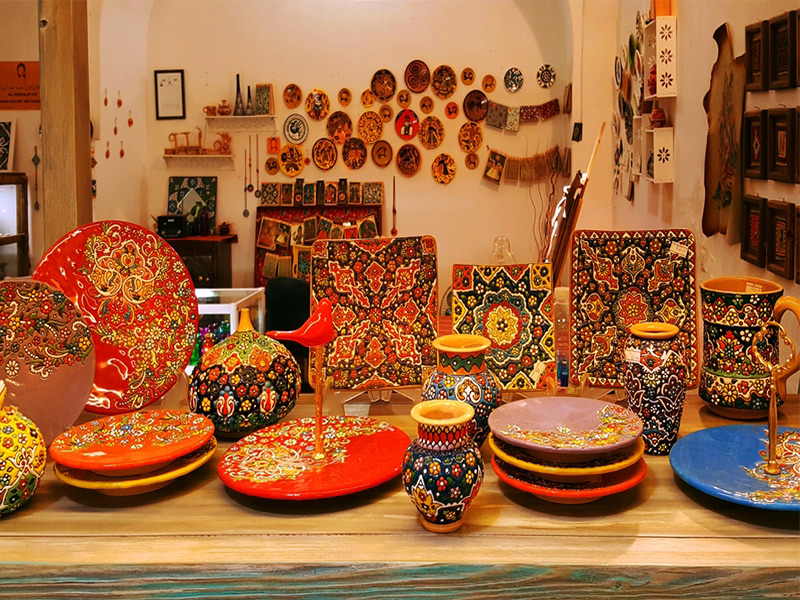
1. Mat Weaving
The first handicraft in Iran that we will discuss is mat weaving. Nowadays, mat weaving is mostly used for home decoration in Iran. This art, which is one of the oldest handicrafts in the world, is created by interweaving plant fibers, specifically reeds. If we trace the footsteps and limited artifacts discovered in Africa and Mesopotamia, we can see that in the past, people used to make mats by weaving marsh plants together. Currently, 16 countries have mat weaving as part of their historical record, with Japan, Korea, and Mexico being among the most famous.
Mat weaving is an industry that is still highly regarded as one of the most popular handicrafts in our country. These mats are made in various shapes and sizes. The raw materials for mat weaving vary in different cities and countries. The selection of suitable wood for making mats is done according to the climate of different regions. The method of mat weaving also varies depending on the climate. However, all mats are made from reed fibers.
Related post
Traveling to Tabriz, a city with a deep history and rich culture
10 of the most spectacular attractions of Shiraz city in Iran
Where is mat weaving practiced in Iran?
As mentioned, mat weaving still has many enthusiasts in the country and is considered one of the most widespread handicrafts in Iran. Mat weaving can be observed in various forms in all cities of Iran, but the provinces of Sistan and Baluchestan, Kurdistan, Khuzestan, Bushehr, Khorasan, Hormozgan, Kerman, Yazd, Fars, Mazandaran, Gilan, East Azerbaijan, and Tehran are among the leading provinces in this industry.
If you have traveled to the northern part of the country, you are probably familiar with the mat-weaving handicrafts of Gilan or the various types of mat-weaving in Mazandaran. In the northern regions of the country, mat weaving is mostly done using machines and is used as floor coverings.
In desert regions like Biabanak and Naien, palm trees are predominantly used, but in other cities like Najafabad, soft stalks of one or two-year-old trees are used. The baskets made in this region are called “ludeh.” In the Qasr-e Shirin area, young branches of date palm trees are used, and they are called “fassil.”
Due to the specific climatic conditions of Sistan and Baluchestan and the affordability of raw materials for mat weaving, the mat weaving industry in that region holds special importance. In Sistan, mat weaving is known as “Asil Bafi,” with “Asil” referring to a type of reed stem. Another wood used in this region is called “tagard.”
Which city in Iran is the best for mat weaving?
Mat weaving is a prevalent and thriving industry in many cities in Iran, and mats can be found in various forms and used for diverse purposes in each city. Therefore, the mat weaving industry is extensive and distinct. The cities that are more famous for their mat weaving industry compared to others and have a special and widespread reputation include Khuzestan due to its abundant palm trees, the northern cities of Iran, especially Gilan, due to the presence of numerous wetlands, and Sistan and Baluchestan due to its climate and affordability of raw materials.
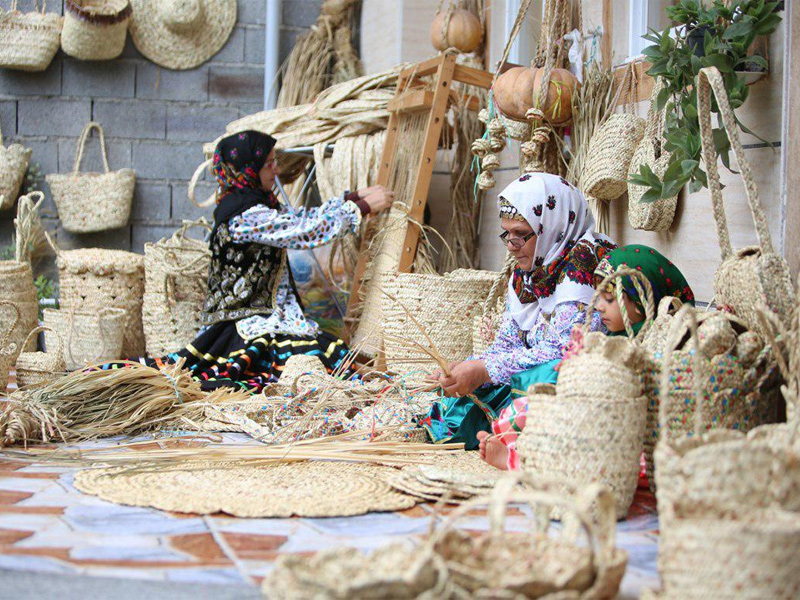
2. Termeh Fabric
The second Iranian handicraft that is highly valuable and captivates your attention is the Termeh fabric. Termeh is one of the exquisite Iranian fabrics that we all recognize with its intricate patterns. The fibers of this fabric are very delicate and are made from various raw materials such as wool, silk, or cotton, and it is produced in a wide range of colors, designs, and patterns. The back of the Termeh fabric has loose wefts and a high density, but the front of the fabric appears completely smooth and uniform.
In which cities of Iran is Termeh fabric produced?
Termeh is produced in various cities, but its origin is in the city of Yazd, and the highest quality ones are woven in this city. Since Yazd was historically located on the Silk Road, textiles and fabrics were the most important commodities traded in this region. Some sources also consider Kerman as the starting point of the Termeh weaving industry. However, the Termeh weaving industry is currently declining and is only active to a limited extent in cities such as Yazd, Kashan, Kerman, and Tehran.
Types of Termeh
These delicate fabrics with their unique and diverse patterns, which are considered one of the Iranian handicrafts, have various types. Here are a few examples of different types of Termeh:
- Charghadi Shawl
- Rah-Rah Shawl
- Kashmiri Shawl
- Atabaki Shawl
- Bandi Shawl
- Moharramat Shawl
- Zomorodi Shawl
- Kerman Shawl
- Amiri Shawl
- Yazdi Shawl
- Kamarbandi Shawl
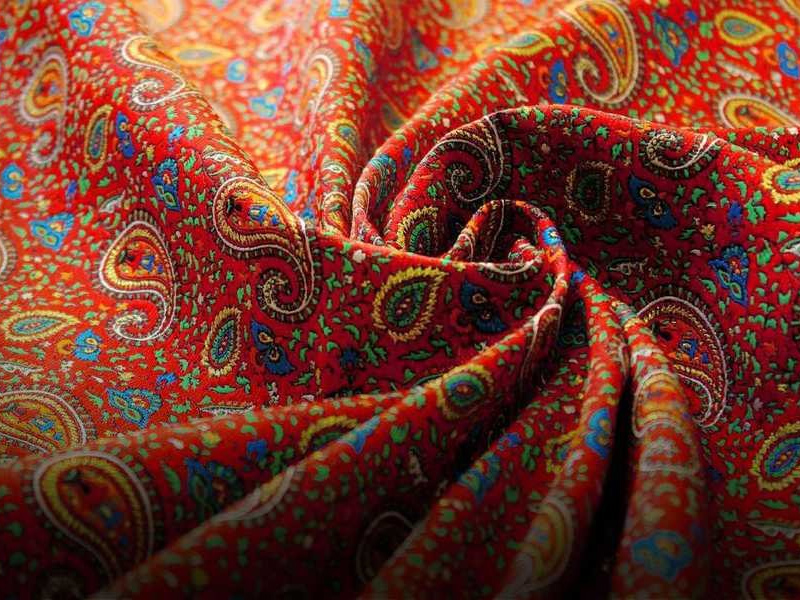
3. Copper Utensils
The first metal that humans were able to discover was copper. History shows that humans had a wide range of uses for copper. They would melt the copper, shape it, and make various tools such as knives. After the widespread use of copper, in addition to essential tools like knives, decorative items such as pendants were also made.
Copper utensils are one of the oldest tools used for cooking and serving. They have a long lifespan, are resistant to heat, and have beautiful colors. Copper utensils are among the most common handicrafts in Iran.
Which cities in Iran have the best copper utensils?
The use of copper dates back to 9,500 years before the Common Era, and in our country, copper and copperwork have a long history in Zanjan province. The use of copper utensils has regained popularity after two decades of using plastic utensils and materials, and these utensils have entered the market with various decorations. Zanjan province is one of the most active provinces in the production of copper products and utensils. After Zanjan, Tehran and Isfahan have the highest number of copper utensils as Iranian handicrafts.
What is the difference between Zanjan copper and Isfahan copper?
Zanjan and Isfahan provinces are both producers of high-quality copper with ancient backgrounds, but there are slight differences between the copper of these two cities that it is better to know. The differences between Zanjan copper and Isfahan copper are:
– Zanjan copper utensils have much more variety compared to Isfahan.
– Isfahan copper artisans produce calligraphy, engraving, and turquoise work, which is produced in Zanjan in very limited quantities.
– High-quality cooking utensils are produced in Zanjan.
– Most of the products of Isfahan copper artisans are decorative utensils.
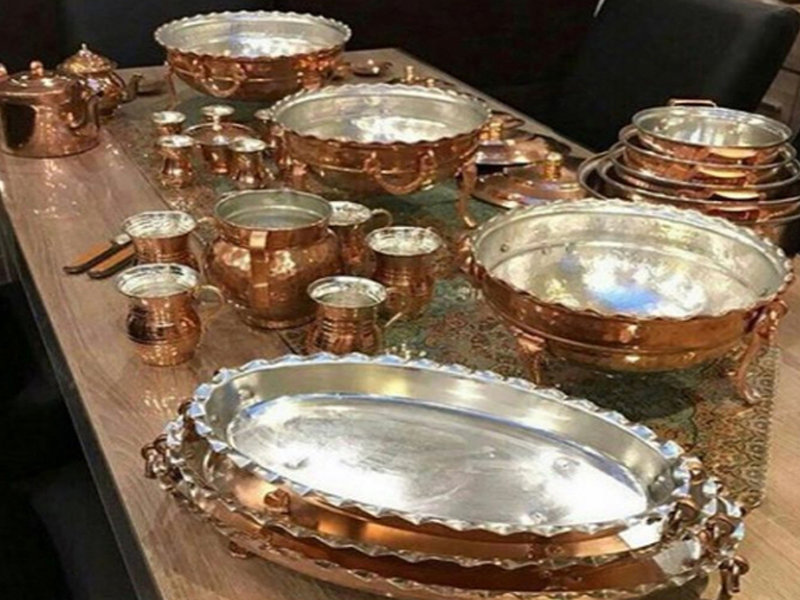
Related points about copper utensils
Although the production of copper utensils is considered one of the Iranian handicrafts, it is also used in our daily lives, especially in cooking. Copper utensils have a special place in kitchens, and it is necessary to know some points about using them for cooking.
– Copper utensils are available in two colors: red (pure copper) and white (tin-plated). For cooking, beverages, various pickles, and other materials that can dissolve copper, it is necessary to use white utensils, which means that the surface in contact with these materials should be tin-plated.
– Excessive copper absorption in the body can lead to poisoning. (As long as there is a layer of tin on the copper, there is no problem.)
– For dry food items such as pastries, you can use copper utensils without tin plating without any concerns.
– To increase the lifespan of utensils and improve cooking, it is recommended to use a gentle flame and moderate heat.
4. Enamelwork (Mina Kari)
Enamelwork is one of the most beautiful handicrafts in Iran, with a history of 5,000 years. The origin of enamelwork can be traced back to Iran, and this beautiful art has spread to other parts of the world. During the Seljuk period, enamelwork reached its peak using brass vessels decorated with enamel. These vessels became widely popular among the people. During the Mongol rule, enamelwork changed and a new method was developed, creating new designs using various shapes and images.
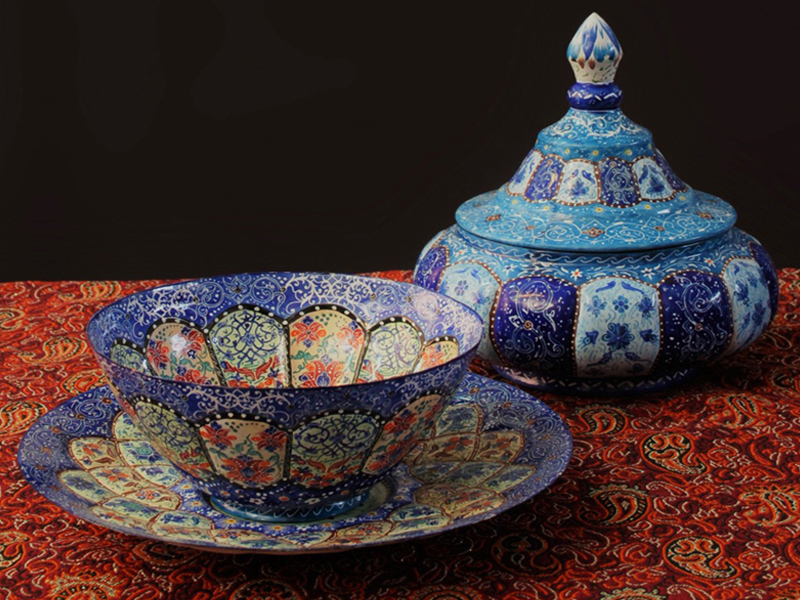
5. Handwoven Carpets
Iranian carpets have been famous worldwide since ancient times. Iranians have been pioneers in carpet weaving, turning Iranian carpets into symbols of art, culture, talent, and authenticity. The history of handwoven Iranian carpets dates back to the Sassanian, Achaemenid, and several hundred years before Christ. Over time, the variety of designs in handwoven carpets has increased, attracting more enthusiasts of this type of carpet. Today, it is difficult to determine which city produces the best handwoven carpets, but carpets from certain regions of Iran, such as Isfahan, are more renowned and have a larger fan base. Handwoven carpets are made using two types of knots: Persian and Turkish.
Types of Authentic Iranian Carpets
The evolution of Iranian handwoven carpets has always been on a path of growth due to the abundant taste and talent of Iranians. As a result, we now have a wide range of authentic Iranian handwoven carpets, which are prominent in Iran’s handicraft industry and beloved and recognized by Iranians and people around the world. The types of authentic Iranian carpets include:
– Gabeh
– Gilim
– Jajim
Today, special carpets with beautiful and unique designs are produced. The most famous ones include:
– Tabriz Carpets
– Kashan Carpets
– Qom Carpets
How can we identify a good Iranian carpet?
In general, Tabriz, Qom, Kashan, and carpets from northern regions of Iran are among the most popular Iranian carpets. Apart from personal preferences, it is advisable to consider factors such as the material used in the carpet, the number of knots per square inch, the serial number and warranty of the carpet, the dimensions of the carpet, and the pile and backing of the carpet to find the best carpet that suits your preferences.
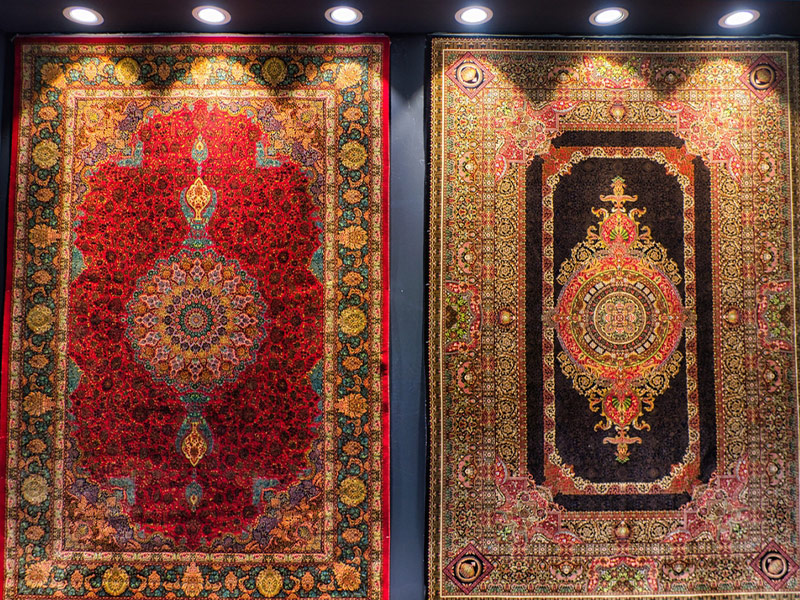
6. Traditional Embroideries of Iran
Another Iranian handicraft is traditional embroideries, which dates back to the era of ancient pottery and ceramics, around 10,000 years ago. Today, traditional embroideries are mostly used for decorative purposes in the modern world.
7. Pottery
Pottery vessels are one of the oldest handmade creations of humanity. Initially, these vessels were used for storing water and food, but as the world progressed and evolved, decorative patterns and designs were added to these pottery vessels.
The oldest pottery wheel and kiln were discovered in Susa, Iran. Additionally, the oldest decorated pottery vessels belong to Iran.
Ceramics are common in several cities in Iran. This ancient art, dating back to ten thousand years ago, is practiced in various parts of Iran, such as Mand Gonabad, Lalejin in Hamedan, Meybod in Yazd, Shahreza in Isfahan, Zenouz in Azerbaijan, Kalpourgan in Sistan and Baluchestan, Jouybar in Mazandaran, and Siahkal in Gilan. However, the capital of ceramics in Iran is Lalejin in Hamadan. Interestingly, the primary occupations of the people in this city are ceramics and agriculture, with ceramics being the main export of the country.
The high-quality ceramics produced in this region are still made using manual wheels.
8. Glassware crafts (Abgineh Handicrafts)
Abgineh is another handicraft in Iran, referring to the art of decorating glass used in various objects. This art has developed based on broken glass and glass fragments and is practiced by artists and craftsmen in cities such as Tehran, Isfahan, Meymand, Qamsar, and more.
Some of the subcategories of the art of Abgineh include mold glassblowing, footed glassblowing, triple-layer glassblowing, double-layer glassblowing, glass engraving, glass etching, and glass matting. Additionally, the combination of this art with enamel and metal handicrafts has resulted in beautiful crafts created by Iranian craftsmen.
In a section of the Ceramic and Abgineh Handicrafts Museum, this beautiful and eye-catching art is displayed. Some of the handicrafts exhibited in the Abgineh Museum date back more than four thousand years, making them worth seeing.
9. Wood Handicrafts
Wood handicrafts are among the most popular handicrafts in Iran. The decoration of wooden works is often done after constructing the main structure. Initially, the main body of the object is created using various woodworking techniques, and then the decorative work is carried out using different methods, either by applying it directly to the surface or by attaching pre-made layers.
Wood, as the primary material for wood handicrafts, has held a special place in art and industry in the land of Iran since ancient times. Wood handicrafts are beautiful and delicate, with various types produced through different techniques, each possessing unique beauty. Woodworking is done through carving, inlaying, latticework, knotting, marquetry, delicate work, seal carving, marquetry carving, marquetry knotting, and wood carving (sculpture).
Furthermore, wood is also used in the construction of musical instruments and is considered part of Iran’s handicrafts.
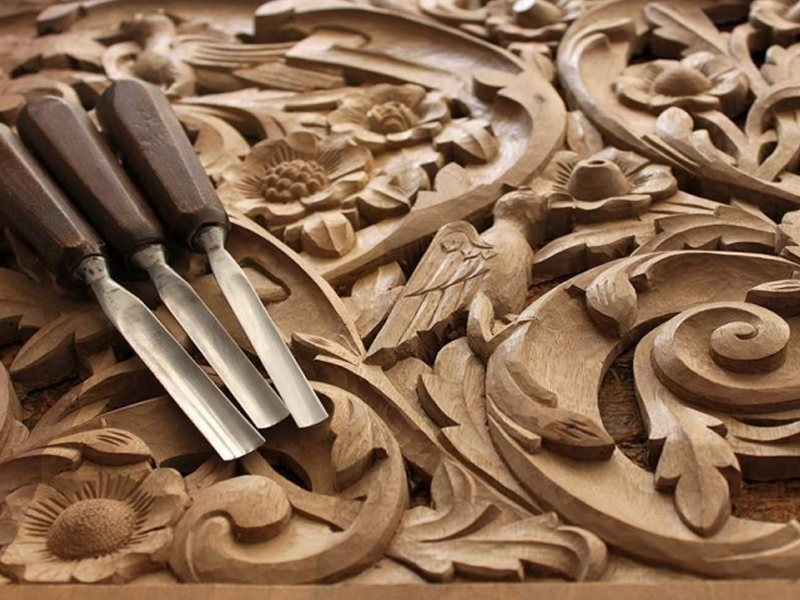
10. Painting (Negargari)
Painting in Iran refers to various styles and techniques of Iranian painting. It is rooted in Iranian poetry and literature and is recognized as one of Iran’s handicrafts. The painter creates converging, parallel, or curvilinear lines and changes the thickness of the lines to create shading and volume in the painting. Line and brushwork are the main pillars of Iranian painting.
Iranian painting or miniature art has five unique characteristics:
- The use of contour lines instead of shading
- The use of luminous space without a specific angle
- Employing vibrant and flat colors
- Emphasizing on surface and avoiding perspective and depth representation
- Displaying objects from the best angle of view
11. Felt-making
Felt and felt-making is a traditional type of fabric produced from wool. Felt is a type of underlay. The interesting point is that felt is not woven like carpets; it is created by applying pressure, moisture, and heat, causing the wool fibers to mat together and form felt. The material used for making felt is sheep’s wool, and it is the quality of the wool that allows for the production of felt. The production of a piece of felt usually takes one day, and felt-makers often work in pairs. Some examples of Iranian handicrafts and felt products include underlays, felt hats, and felt coats (kapanak).
Felt is produced in most cities in Iran. The major production centers are in Estahban, Fars, various cities in Gilan and Mazandaran, Semnan, Damghan, Ghoochan, Chaharmahal and Bakhtiari, and Kermanshah. It can be said that the best and highest quality felts in Iran are produced in Chaharmahal and Bakhtiari. Due to the quality, diversity, innovation, and creativity in felt production in this province, the city of Shahrekord was chosen as the National Felt City in July 2015.
12. Leather Handicrafts
Throughout history, humans have used leather for making clothing, shoes, and even writing on leather pages. Over time, humans have been able to create various handicrafts in the field of leather. Leather is one of the most popular and common handicrafts in Iran and has remained popular from the past until now.
The first industrial factories for producing various types of natural leather were established in the provinces of Tabriz, Mashhad, and Isfahan.
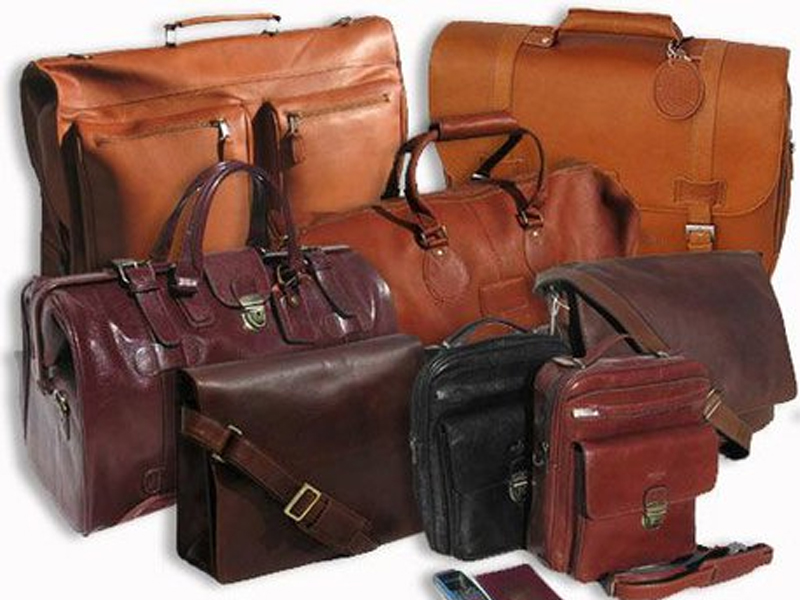
Types of Leather Handicrafts
Leather is a natural, durable, and flexible material obtained from tanning raw animal hides, such as cowhide. Most provinces in Iran are active in the leather industry, but if we want to mention the most prosperous and famous ones, Hamedan is at the forefront of leather product production. After Hamedan, the cities of Tabriz, Tehran, East Azerbaijan, Khorasan, Alborz, and Isfahan are leading in leather production. The most important types of leather handicrafts include:
- Traditional saddle-making (hand-stitched leather)
- Leather bookbinding
- Leather burning
- Leather engraving
- Leather painting
Final words
Iranian handicrafts hold a special place in the world. Despite the great art and creativity involved in these handicrafts, there is a lot of effort hidden behind each of these artistic works. Familiarity with handicrafts in Iran is like a journey into the past and introduces us to Iranian art and creativity. Through this introduction, we have familiarized you with 12 of the most fascinating Iranian handicrafts, such as enamelwork, painting, mirror work, and more. Although in some cities, handicrafts are not supported as they should be, and some Iranian handicrafts, such as Termeh weaving, are becoming obsolete, we have tried to contribute, even in a small way, to the preservation of these arts by introducing these handicrafts and beautiful arts.
Frequently Asked Questions
1- What plant is used in straw weaving?
The plant used in straw weaving varies depending on different climates. In tropical regions, they mostly use date palm leaves, wild palm leaves, and swamp reed stems. Some of the plants used in southern regions include Kortak (a type of swamp reed) and Daz (a type of wild palm wood).
2- What is Termeh fabric made of?
High-quality Termeh fabric should be made of natural silk and cotton threads. Silk, thread, or wool are used for the weft of this fabric. Although most modern Termeh fabrics have a viscose rayon weft and a cotton or polyester warp.
3- Why is the use of copper utensils recommended for cooking?
Copper utensils, with proper heat conduction, make the food cook better and become more delicious. Additionally, the food will be cooked faster.
4- Why is the price of handmade Iranian carpets higher?
Handmade carpets are considered one of the oldest and most authentic carpets, and they have higher material and intrinsic value. The primary materials used in weaving handmade carpets are pure wool, silk, and cotton. Machine-made carpets often contain a percentage of synthetic materials, which reduces the price of the carpet.
5- What is pen-holding in Negargari?
Pen-holding refers to the way an artist holds the pen or brush. The pen or brush should be held vertically with two fingers on the handle to facilitate movement in any direction.
